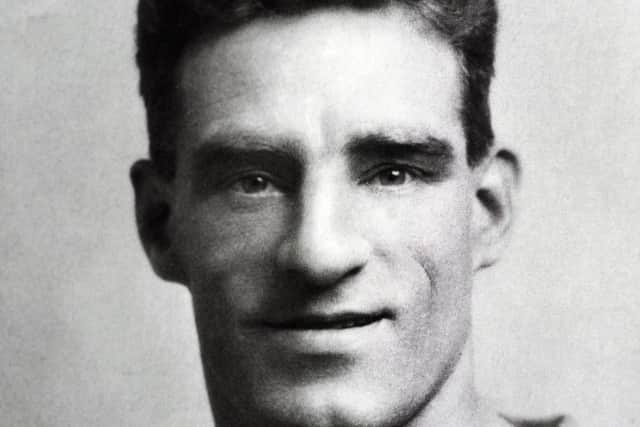How Leeds United's record buy was shipwrecked before plundering goals galore
and live on Freeview channel 276
Jennings was born on March 8 1902 in Strathaven, an historic market town in South Lanarkshire and began to make his name playing for junior side Cadzow St Anne’s, with whom he won a Juvenile Cup medal.
His progress was not unnoticed and in 1919 he was invited down to London for a trial with Tottenham Hotspur.
Advertisement
Hide AdAdvertisement
Hide AdUnfortunately for the striker nothing materialised at White Hart Lane but a move to Raith, where his brother Charlie was on the books, came about in January 1921 and he went on to play his part in a free-scoring front line.
During his time in Kirkcaldy, Jennings rattled in 73 league goals in 134 games and he was part of the Raith side that were shipwrecked in the summer of 1923.
The club had visited Copenhagen the previous summer and decided to embark on a journey to the Canary Islands where they would play four games.
Players, management and club officials boarded the ship, the Highland Loch, which was stopping off at the Canaries on its way to Buenos Aires, unaware of the drama that would unfold.
Advertisement
Hide AdAdvertisement
Hide AdUpon reaching northern Spain, the ship ran aground in extremely violent weather conditions.


The contingent from Raith and other passengers were rescued by local fishermen and taken to the village of Villagarcia where they were picked up the following day by a passing liner.
They reached their destination a few days later.
Incidentally, the sobering experience had no adverse impact on the players as they won all four games of the tour.
Despite the goals flowing, Jennings requested a move away from the club and upon placing him on the transfer list at the end of February 1925, the Raith Rovers directors made it clear that any suitable offers would be considered.
Fairclough soon made his move.
Advertisement
Hide AdAdvertisement
Hide AdThe YEP reported on March 12 1925, that the Elland Road outfit were in talks to sign a ‘well known player’ and the following day a deal was done.
‘Leeds United secure a crack centre – one of the best in the Scottish League’ was how the YEP headlined the report.
Fairclough had travelled to Glasgow to get his man, for a club record fee of £3,000, and the transfer created excitement among the Leeds followers.
A correspondent in Glasgow sent a telegram to the Leeds newspaper in which he claimed Jennings was regarded as one of the cleverest centre-forwards in Scotland, a master craftsman.
Advertisement
Hide AdAdvertisement
Hide AdAlthough there were several Scotsmen on the books at Elland Road, Tom Jennings was the first player to sign for Leeds directly from Scotland and the new man was thrust straight into first team action.
The ink had barely dried on the paperwork when he stepped out for his debut, within 24 hours of completing his move, in a 1-1 draw with Sheffield United.
Jennings had to wait until March 28 for his first goal, in an Elland Road thrashing of Liverpool.
Leeds bounced back and were leading 3-1 when Jennings produced a fine solo effort.
Advertisement
Hide AdAdvertisement
Hide AdBy the end of a campaign, in which Leeds largely struggled, Jennings had scored three in 10 games whilst his partner in crime, Russell Wainscoat bagged four in nine.
The goals went a long way in executing any relegation fears as the club finished 18th.
Despite the duo’s goals the following season, Leeds sailed murky waters at the foot of the First Division and escaped relegation by a single point.
Jennings played every game and scored 26 goals.
The personal highlight for the Scotsman came on February 6 1926 when title-chasing Arsenal found themselves 4-0 down at half-time at Elland Road, Jennings grabbing three.
Advertisement
Hide AdAdvertisement
Hide AdArsenal rallied in the second half with two goals but the points belonged to United and the plaudits to Jennings.
The 1926/27 season was remarkable for the fact that Leeds, who finally fell through the top flight trap door, had a striker in blistering form.
Their Scottish goal machine only missed one league and managed to find the back of the net 35 times.
A devastating 14-game spell between September 4 and November 20 1926 saw him score 22 times, including 11 in three consecutive games against Arsenal, Liverpool and Blackburn – the first time in division history a straight hat-trick of hat-tricks had been achieved.
Advertisement
Hide AdAdvertisement
Hide AdIn today’s football, there would be no way Leeds would have been able to keep hold of their deadly marksman following relegation, but the love affair was not about to end.
Jennings and Wainscoat remained at the club and fired Leeds back into the top flight at the first attempt.
Despite only playing six games after Christmas, Jennings scored 21 times over a season in which he suffered from blood poisoning.
Over the next three seasons Jennings was restricted to 51 games in which he found the net 30 times. Quite simply, when fit he would score, more often than not.
Advertisement
Hide AdAdvertisement
Hide AdHis final Leeds’ goal came in his 170th appearance, at home to Sheffield Wednesday. It was the 117th time that he had put the ball in the net in a Leeds shirt.
Jennings left Elland Road in June 1931 to join Chester City.
Incredibly, the master craftsman never received international recognition during his career but the man signed from Raith, the Whites’ fourth highest goalscorer of all time, was box office.
On July 2 1973, Jennings passed away.
The hardest thing to do on a football field is to put the ball in the net yet the Scotsman did it with ease, at every level he played. What would he be worth in today’s market?